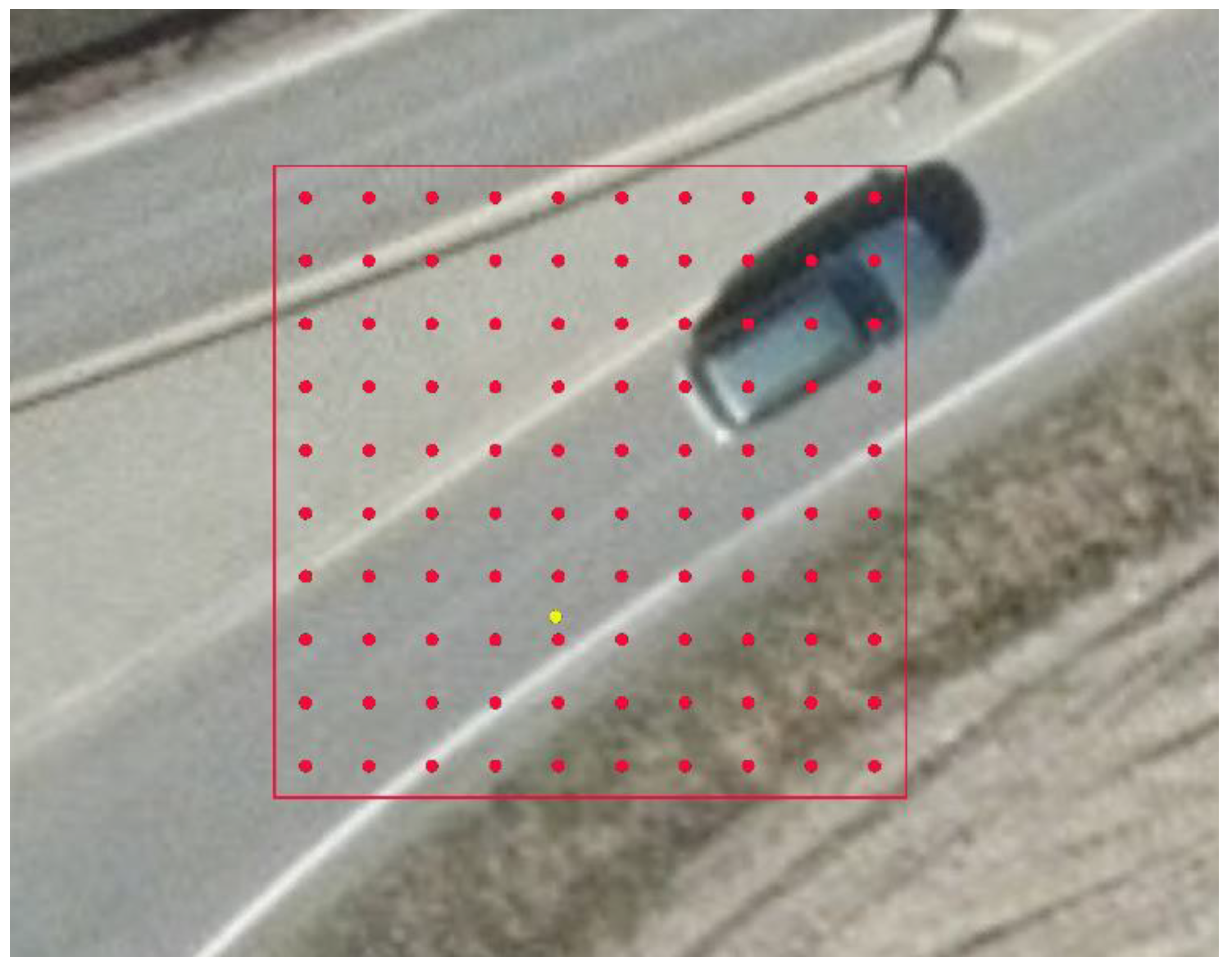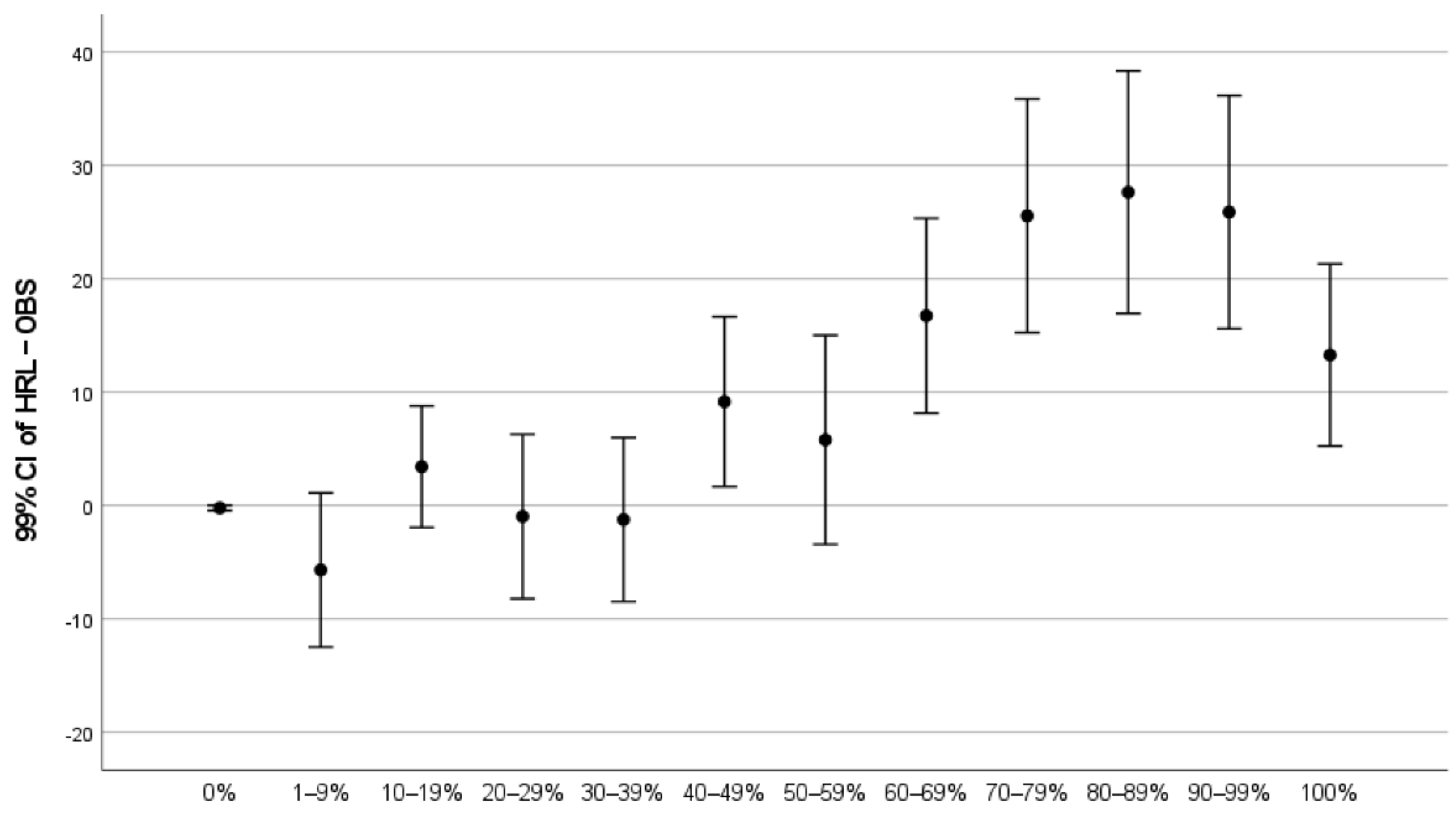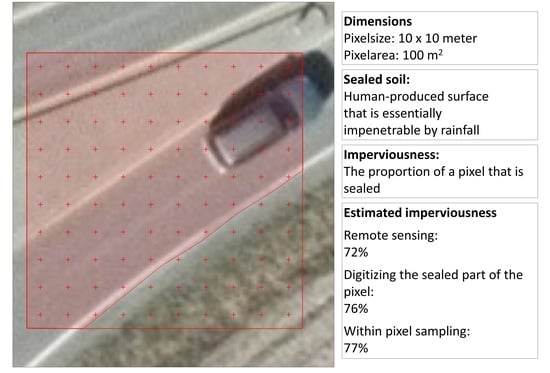Accuracy of the Copernicus High-Resolution Layer Imperviousness Density (HRL IMD) Assessed by Point Sampling within Pixels
Abstract
1. Introduction
2. Materials and Methods
3. Results
4. Discussion
4.1. The Accuracy Assessment of HRL IMD
4.2. The Sampling Methodology
4.3. Alternative Approaches
4.4. Applicability to Other Remote Sensing Products
5. Conclusions
Funding
Data Availability Statement
Conflicts of Interest
References
- Meyer, W.B.; Turner, B.L. Human population growth and global land-use/cover change. Annu. Rev. Ecol. Syst. 1992, 23, 39–61. [Google Scholar] [CrossRef]
- Jennings, D.B.; Taylor Jarnagin, S. Changes in anthropogenic impervious surfaces, precipitation and daily streamflow discharge: A historical perspective in a mid-Atlantic subwatershed. Landsc. Ecol. 2002, 17, 471–489. [Google Scholar] [CrossRef]
- Burghardt, W. Soil sealing and soil properties related to sealing. Geol. Soc. Lond. Spec. Publ. 2006, 266, 117–124. [Google Scholar] [CrossRef]
- Arnold, C.L., Jr.; Gibbons, C.J. Impervious surface coverage: The emergence of a key environmental indicator. J. Am. Plan. Assoc. 1996, 62, 243–258. [Google Scholar] [CrossRef]
- Shuster, W.D.; Bonta, J.; Thurston, H.; Warnemuende, E.; Smith, D.R. Impacts of impervious surface on watershed hydrology: A review. Urban Water J. 2005, 2, 263–275. [Google Scholar] [CrossRef]
- Jacobson, C.R. Identification and quantification of the hydrological impacts of imperviousness in urban catchments: A review. J. Environ. Manag. 2011, 92, 1438–1448. [Google Scholar] [CrossRef] [PubMed]
- Tobias, S.; Conen, F.; Duss, A.; Wenzel, L.M.; Buser, C.; Alewell, C. Soil sealing and unsealing: State of the art and examples. Land Degrad. Dev. 2018, 29, 2015–2024. [Google Scholar] [CrossRef]
- Li, J.; Pei, Y.; Zhao, S.; Xiao, R.; Sang, X.; Zhang, C. A review of remote sensing for environmental monitoring in China. Remote Sens. 2020, 12, 1130. [Google Scholar] [CrossRef]
- Slonecker, E.T.; Jennings, D.B.; Garofalo, D. Remote sensing of impervious surfaces: A review. Remote Sens. Rev. 2001, 20, 227–255. [Google Scholar] [CrossRef]
- Yang, L.; Huang, C.; Homer, C.; Wylie, B.; Coan, M. An approach for mapping large-area impervious surfaces: Synergistic use of Landsat 7 ETM+ and high spatial resolution imagery. Can. J. Remote Sens. 2002, 29, 230–240. [Google Scholar] [CrossRef]
- Homer, C.; Huang, C.; Yang, L.; Wylie, B.; Coan, M. Development of a 2001 national land-cover database for the United States. Photogramm. Eng. Remote Sens. 2004, 70, 829–840. [Google Scholar] [CrossRef]
- Raymaekers, D.; Bauwens, I.; Van Orshoven, J.; Gulinck, H.; Engel, B.; Dosselaere, N. Spectral unmixing of low resolution images for monitoring soil sealing. In Urban 2005, Proceedings of the 3rd International Symposium Remote Sensing and Data Fusion Over Urban Areas, Tempe, AZ, USA, 14–16 March 2005; ISPRS: Hannover, Germany, 14–16 March 2005. [Google Scholar]
- Kampouraki, M.; Wood, G.A.; Brewer, T.R. The application of remote sensing to identify and measure sealed areas in urban environments. In Bridging Remote Sensing and GIS, Proceedings of the 1st International Conference on Object-Based Image Analysis, Salzburg, Austria, 4–6 June 2006; ISPRS: Hannover, Germany, 2006. [Google Scholar]
- Kampouraki, M.; Wood, G.A.; Brewer, T.R. The suitability of object-based image segmentation to replace manual aerial photo interpretation for mapping impermeable land cover. In Challenges for Earth Observation: Scientific, Technical and Commercial, 426–430, Proceedings of the Remote Sensing and Photogrammetry Society Annual Conference, Newcastle Upon Tyne, UK, 11–14 September 2007; Heipke, C., Ed.; Remote Sensing and Photogrammetry Society (RSPSoc): Nottingham, Germany, 2007. [Google Scholar]
- Weng, Q. Remote sensing of impervious surfaces in the urban areas: Requirements, methods, and trends. Remote Sens. Environ. 2012, 117, 34–49. [Google Scholar] [CrossRef]
- Salvati, L. The spatial pattern of soil sealing along the urban-rural gradient in a Mediterranean region. J. Environ. Plan. Manag. 2014, 57, 848–861. [Google Scholar] [CrossRef]
- Kuc, G.; Chormański, J. Sentinel-2 imagery for mapping and monitoring imperviousness in urban areas. The International Archives of Photogrammetry. Remote Sens. Spat. Inf. Sci. 2019, 42, 43–47. [Google Scholar] [CrossRef]
- Shrestha, B.; Ahmad, S.; Stephen, H. Fusion of Sentinel-1 and Sentinel-2 data in mapping the impervious surfaces at city scale. Environ. Monit. Assess. 2021, 193, 556. [Google Scholar] [CrossRef]
- Peroni, F.; Pappalardo, S.E.; Facchinelli, F.; Crescini, E.; Munafò, M.; Hodgson, M.E.; De Marchi, M. How to map soil sealing, land take and impervious surfaces? A systematic review. Environ. Res. Lett. 2022, 17, 053005. [Google Scholar] [CrossRef]
- Moglen, G.E.; Kim, S. Limiting imperviousness: Are threshold-based policies a good idea? J. Am. Plan. Assoc. 2007, 73, 161–171. [Google Scholar] [CrossRef]
- Parent, J.R.; Lei, Q. Estimating percent impervious cover from Landsat-based land cover with a simple and transferable regression model. Int. J. Remote Sens. 2018, 39, 3839–3851. [Google Scholar] [CrossRef]
- Lefebvre, A.; Sannier, C.; Corpetti, T. Monitoring urban areas with Sentinel-2A data: Application to the update of the Copernicus high resolution layer imperviousness degree. Remote Sens. 2016, 8, 606. [Google Scholar] [CrossRef]
- European Environment Agency. The European Environment—State and Outlook 2020. Knowledge for Transition to a Sustainable Europe; Publications office of the European Union: Luxembourg, 2019.
- Vysna, V.; Maes, J.; Petersen, J.E.; La Notte, A.; Vallecillo, S.; Aizpurua, N.; Ivits, E.; Teller, A. Accounting for ecosystems and their services in the European Union (INCA). Final Report from Phase II of the INCA Project Aiming to Develop a Pilot for an Integrated System of Ecosystem Accounts for the EU; Statistical Report; Publications office of the European Union: Luxembourg, 2021.
- Congedo, L.; Sallustio, L.; Munafò, M.; Ottaviano, M.; Tonti, D.; Marchetti, M. Copernicus high-resolution layers for land cover classification in Italy. J. Maps 2016, 12, 1195–1205. [Google Scholar] [CrossRef]
- Smith, G. GMES Initial Operations/Copernicus Land Monitoring Services—Validation of Products. HRL Imperviousness Degree 2015 Validation Report. GIO HRL IMD Validation Report SC03, Issue D1.3. 2019. Available online: https://land.copernicus.eu/user-corner/technical-library/hrl-imperviousness-2015-validation-report (accessed on 7 June 2022).
- Wickham, J.D.; Stehman, S.V.; Gass, L.; Dewitz, J.; Fry, J.A.; Wade, T.G. Accuracy assessment of NLCD 2006 land cover and impervious surface. Remote Sens. Environ. 2013, 130, 294–304. [Google Scholar] [CrossRef]
- Steidl, M.; Schleicher, C.; Sannier, C. Copernicus Land Monitoring Service—High Resolution Layer Imperviousness: Product Specifications Document; European Environment Agency: Copenhagen, Denmark, 2018.
- Lohr, S.L. Sampling: Design and Analysis, 2nd ed.; CRC Press: Boka Raton, FL, USA, 2019. [Google Scholar]
- Cochran, W.G. Sampling Techniques, 3rd ed.; John Wiley & Sons: New York, NY, USA, 1977. [Google Scholar]
- Krówczyńska, M.; Soszyńska, A.; Pabjanek, P.; Wilk, E.; Hurbanek, P.; Rosina, K. Accuracy of the soil sealing enhancement product for Poland. Quaest. Geogr. 2016, 35, 89–95. [Google Scholar] [CrossRef][Green Version]
- Pabjanek, P.; Krówczyńsk, M.; Wilk, E.; Miecznikowski1, M. An accuracy assessment of European Soil Sealing Dataset (SSL2009): Stara Miłosna area, Poland—A case study. Misc. Geogr. Reg. Stud. Dev. 2016, 20, 59–63. [Google Scholar] [CrossRef][Green Version]
- Hurbanek, P.; Atkinson, P.M.; Pazur, R.; Rosina, K.; Chockalingam, J. Accuracy of built-up area mapping in Europe at varying scales and thresholds. In Proceedings of the Accuracy 2010, Ninth International Symposium on Spatial Accuracy Assessment in Natural Resources and Environmental Sciences, Leicester, England, 20–23 July 2010; University of Leicester: Leicester, UK, 2010; Volume 385388. [Google Scholar]
- Strand, G.H. A study of variance estimation methods for systematic spatial sampling. Spat. Stat. 2017, 21, 226–240. [Google Scholar] [CrossRef]
- Magnussen, S.; Nord-Larsen, T. Design-consistent model-based variances with systematic sampling: A case study with the Danish national Forest inventory. Commun. Stat. Simul. Comput. 2021, 50, 38–48. [Google Scholar] [CrossRef]
- Aune-Lundberg, L.; Strand, G.H. Comparison of variance estimation methods for use with two-dimensional systematic sampling of land use/land cover data. Environ. Model. Softw. 2014, 61, 87–97. [Google Scholar] [CrossRef]
- Brus, D.J.; Saby, N.P. Approximating the variance of estimated means for systematic random sampling, illustrated with data of the French Soil Monitoring Network. Geoderma 2016, 279, 77–86. [Google Scholar] [CrossRef]
- Strand, G.H.; Dramstad, W.; Engan, G. The effect of field experience on the accuracy of identifying land cover types in aerial photographs. Int. J. Appl. Earth Obs. Geoinf. 2002, 4, 137–146. [Google Scholar] [CrossRef]
- Aronoff, S. The map accuracy report: A user’s view. Photogramm. Eng. Remote Sens. 1982, 48, 1309–1312. [Google Scholar]
- Congalton, R.G. A review of assessing the accuracy of classifications of remotely sensed data. Remote Sens. Environ. 1991, 37, 35–46. [Google Scholar] [CrossRef]
- Available online: https://land.copernicus.eu/pan-european/high-resolution-layers/grassland (accessed on 7 June 2022).
- Aune-Lundberg, L.; Strand, G.H. The content and accuracy of the CORINE Land Cover dataset for Norway. Int. J. Appl. Earth Obs. Geoinf. 2021, 96, 102266. [Google Scholar] [CrossRef]
- Drašković, B.J. Urban expansion of the largest cities in Bosnia and Herzegovina over the period 2000–2018. Geogr. Pannonica 2021, 25. [Google Scholar] [CrossRef]
- Pagliarin, S. Supra-local spatial planning practices and suburban patterns in the Barcelona and Milan urban regions. Land Use Policy 2022, 112, 105816. [Google Scholar] [CrossRef]
- Cole, B.; Smith, G.; Balzter, H. Acceleration and fragmentation of CORINE land cover changes in the United Kingdom from 2006–2012 detected by Copernicus IMAGE2012 satellite data. Int. J. Appl. Earth Obs. Geoinf. 2018, 73, 107–122. [Google Scholar] [CrossRef]
- Rosina, K.; e Silva, F.B.; Vizcaino, P.; Herrera, M.M.; Freire, S.; Schiavina, M. Increasing the detail of European land use/cover data by combining heterogeneous data sets. Int. J. Digit. Earth 2020, 13. [Google Scholar] [CrossRef]
- Manakos, I.; Tomaszewska, M.; Gkinis, I.; Brovkina, O.; Filchev, L.; Genc, L.; Gitas, I.Z.; Halabuk, A.; Inalpulat, M.; Irimescu, A.; et al. Comparison of global and continental land cover products for selected study areas in South Central and Eastern European region. Remote Sens. 2018, 10, 1967. [Google Scholar] [CrossRef]


| Stratum | Area (HRL IMD) | High-Resolution Layer (HRL IMD) | Estimated from Aerial Photographs | ||
|---|---|---|---|---|---|
| (%) | (Hectare) | Mean (%) | Sealed (Ha) | Mean (%) | Sealed (Ha) |
| 100 | 24,273 | 100.00 | 24,273 | 86.72 | 21,050 |
| 90–99 | 7647 | 94.27 | 7209 | 68.41 | 5231 |
| 80–89 | 8358 | 84.33 | 7048 | 56.77 | 4745 |
| 70–79 | 10,818 | 74.53 | 8063 | 49.01 | 5302 |
| 60–69 | 12,685 | 64.65 | 8201 | 47.47 | 6022 |
| 50–59 | 17,071 | 53.97 | 9213 | 48.33 | 8251 |
| 40–49 | 31,535 | 44.29 | 13,967 | 35.11 | 11,072 |
| 30–39 | 38,588 | 34.34 | 13,250 | 35.63 | 13,749 |
| 20–29 | 33,105 | 24.78 | 8204 | 26.23 | 8684 |
| 10–19 | 15,204 | 15.60 | 2373 | 12.02 | 1828 |
| 1–9 | 2430 | 6.56 | 159 | 12.24 | 298 |
| Subtotal | 201,715 | 50.55 | 101,961 | 42.75 | 86,229 |
| 0% | 32,179,185 | 0.00 | 0 | 0.21 | 67,576 |
| Total | 32,380,900 | 0.31 | 101,961 | 0.47 | 153,805 |
| 99% CI | |||||||
|---|---|---|---|---|---|---|---|
| (%) | HRL % | OBS % | Diff | Serr | Lower | Upper | Sign |
| 100 | 100.00 | 86.72 | 13.28 | 3.06 | 5.40 | 21.16 | ** |
| 90–99 | 94.27 | 68.41 | 25.86 | 3.92 | 15.76 | 35.96 | ** |
| 80–89 | 84.33 | 56.77 | 27.56 | 4.07 | 17.08 | 38.04 | ** |
| 70–79 | 74.53 | 49.01 | 25.52 | 3.93 | 15.40 | 35.64 | ** |
| 60–69 | 64.65 | 47.47 | 17.18 | 3.27 | 8.76 | 25.60 | ** |
| 50–59 | 53.97 | 48.33 | 5.64 | 3.51 | −3.40 | 14.68 | - |
| 40–49 | 44.29 | 35.11 | 9.18 | 2.85 | 1.84 | 16.52 | ** |
| 30–39 | 34.34 | 35.63 | −1.29 | 2.75 | −8.37 | 5.79 | - |
| 20–29 | 24.78 | 26.23 | −1.45 | 2.76 | −8.56 | 5.66 | - |
| 10–19 | 15.60 | 12.02 | 3.58 | 2.04 | −1.68 | 8.84 | - |
| 1–9 | 6.56 | 12.24 | −5.68 | 2.58 | −12.33 | 0.97 | - |
| Subtotal | 50.55 | 42.75 | 7.80 | 0.95 | 5.35 | 10.25 | ** |
| 0% | 0.00 | 0.21 | −0.21 | 0.09 | −0.44 | 0.02 | - |
| Total | 0.31 | 0.47 | −0.16 | 1.09 | −2.97 | 2.65 | - |
Publisher’s Note: MDPI stays neutral with regard to jurisdictional claims in published maps and institutional affiliations. |
© 2022 by the author. Licensee MDPI, Basel, Switzerland. This article is an open access article distributed under the terms and conditions of the Creative Commons Attribution (CC BY) license (https://creativecommons.org/licenses/by/4.0/).
Share and Cite
Strand, G.-H. Accuracy of the Copernicus High-Resolution Layer Imperviousness Density (HRL IMD) Assessed by Point Sampling within Pixels. Remote Sens. 2022, 14, 3589. https://doi.org/10.3390/rs14153589
Strand G-H. Accuracy of the Copernicus High-Resolution Layer Imperviousness Density (HRL IMD) Assessed by Point Sampling within Pixels. Remote Sensing. 2022; 14(15):3589. https://doi.org/10.3390/rs14153589
Chicago/Turabian StyleStrand, Geir-Harald. 2022. "Accuracy of the Copernicus High-Resolution Layer Imperviousness Density (HRL IMD) Assessed by Point Sampling within Pixels" Remote Sensing 14, no. 15: 3589. https://doi.org/10.3390/rs14153589
APA StyleStrand, G.-H. (2022). Accuracy of the Copernicus High-Resolution Layer Imperviousness Density (HRL IMD) Assessed by Point Sampling within Pixels. Remote Sensing, 14(15), 3589. https://doi.org/10.3390/rs14153589







